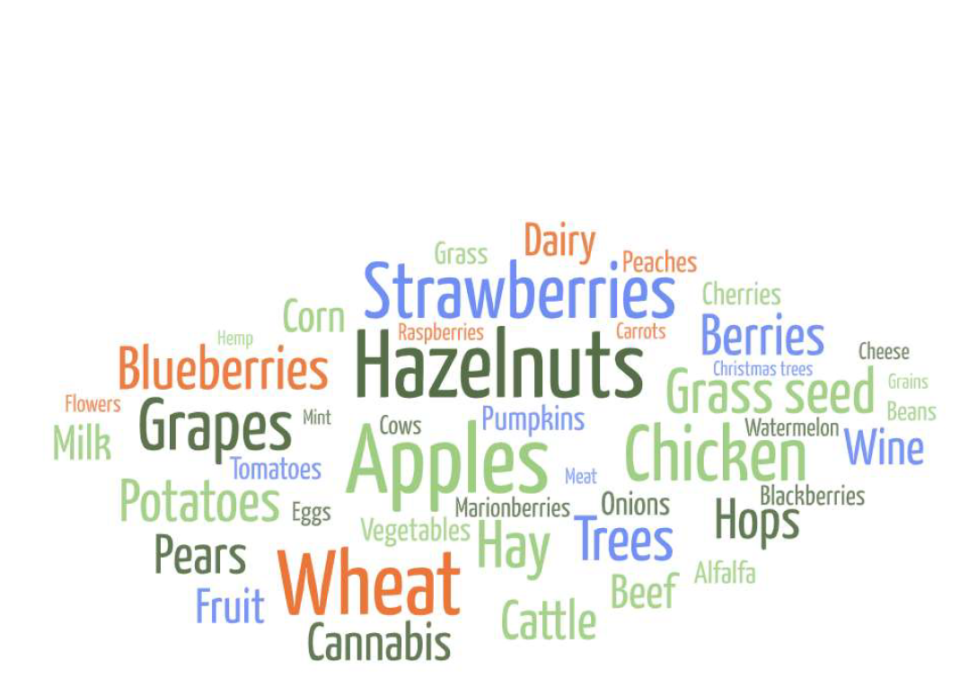- In their own words, what comes to mind when Oregonians think of “farming” or “agriculture”, what are Oregon’s top three agricultural products based on production value, and which agricultural products are top of mind. Closed-ended questions as to what qualifies as farming and what doesn’t, and how they feel about large-scale industrial or commercial farms compared to small-scale farms.
OVBC MAY – JUNE 2023
FARMING AND AGRICULTURE IN OREGON: FREE ASSOCIATION
OREGONIANS BY THE NUMBERS AND IN THEIR OWN WORDS
INTRODUCTION
From May 26 – June 5, 2023, the Oregon Values and Beliefs Center conducted a statewide survey of Oregonians’ attitudes and behavior related to farming and agriculture including differences in feelings about small-scale farms and large-scale commercial or industrial farms. A description of the methodology used for the research is provided below. A Spanish version of the questionnaire was developed for the study in partnership with Rural Development Initiatives; the values and beliefs of Spanish-speaking Oregonians are included in the findings.
This highlights memo summarizes key findings for questions related to the semantics and imagery Oregonians associate with farming and agriculture. Other memos have been prepared for the values and beliefs Oregonians have about farming/agriculture, U.S. agricultural subsidies, and the personal connection Oregonians have with farming/agriculture.
The question numbers in this document correspond with the accompanying annotated questionnaire and tabs. Due to rounding, the percentages reported below may not add up to 100% or compare exactly to the percentages for the same question in the annotated questionnaire or tabs.
Included below for selected questions are noteworthy subgroup variations for BIPOC/white, age, urban/rural, education, gender, and households with and without children. The accompanying set of tabs notes subgroup variations for all the questions.
OVBC surveys currently use aggregated data to analyze the opinions of BIPOC residents in comparison to the opinions of residents who identify as white and not another race. BIPOC residents are not a monolith; the grouping represents a wide diversity of races and ethnicities. The findings included in this memo should not be construed such that all people of color are believed to share the same opinions. Disaggregated race data will be provided when sample sizes permit reliability.
For survey full question wording, all statistically significant subgroup findings, and respondent quotes, readers are encouraged to refer to the accompanying documents: (1) annotated questionnaire, (2) crosstabulations document, and (3) verbatim written responses spreadsheet, including open-ended responses, sortable by demographics including County.
Oregon Values and Beliefs Center (OVBC): This research was completed as a community service by the Oregon Values and Beliefs Center. OVBC is an independent and non-partisan organization and an Oregon charitable nonprofit corporation. Representative OVBC projects include opinion research about race-based crimes for the Asian Health and Service Center, as well as research about early childhood education and the cost of childcare for the Children’s Institute.
IMPRESSIONS OF FARMING & AGRICULTURE
- The survey opened with an invitation for Oregonians to share their thoughts on either farming or agriculture without any specific prompts. Participants were split-sampled, as half were asked for their associations with “farming” (Q1), while the other half were asked to respond to “agriculture” (Q3). Both “farming” and “agriculture” elicit similar overall themes. Many people recall the tradition and history of farming in Oregon, emphasizing their pride in the industry. Below are some representative quotes:
“Rural Oregon, hard-working, needs support, a vital part of our ecosystem.”
Man, age 45-54, Multnomah County, Black or African American
“Important for many reasons, provides needed, healthy food, close by, provides jobs and income, pride in Oregon, our land, our environment.”
Woman, age 65-74, Lane County, Prefers not to share race
“Largest or second-largest income source in state–either ahead of logging and forestry or just behind it.”
Man, age 75+, Benton County, White
“Oregon’s 37,200 farms, spread across 16 million acres.”
Transgender Man, age 18-29, Coos County, Hispanic/Latino/a/x,
- Some respondents list crops and goods that come to mind. People in the agriculture group are more likely to provide such a list.
“I tend to think of berry farms and apples as I know those are common crops. I also think of certain food co-ops and radical farming organizations that I know people who are members of.”
Woman, age 18-29, Clackamas County, Black or African American and Hispanic/Latina/x
“The bounty of wheat, grass seed, trees and marine products, amongst many others, that so enrich our communities.”
Man, age 18-29, Clackamas County, White
“Cow, horses, pigs, hay, oats, plowing the ground, cutting the hay, bailing the hay, gathering the bails to put on a wagon to take to the where you put the bales of hay to stack on top of one another. Watering the fields with water from a ditch or sprinklers.”
Woman, age 65-74, Lincoln County, White
- Many responses relate to place, discussing the counties in which crops are grown. Survey-takers in the farming split sample provide this type of answer more often.
“Produce and fruits, specialty field crops in Willamette valley, tree fruit from the Gorge, wheat from the Columbia plateau, onions and potatoes from Ontario, also that sugar beet plant in Nyssa. Oregon is a leader in modern and regenerative agriculture.”
Non-binary or gender non-conforming, age 30-44, Baker County, White
“I think Oregon has diverse crops. Most of this is done south of Salem. Everything from grass seeds, grapes, etc., plus in Jackson County there are quite a few small farms that are open to the public.”
Man, age 65-74, Jackson County, White
“Southern Oregon where I’m from is very beautiful and known for their pear crops and countless vineyards, which all grow the sweetest fruit.”
Woman, age 18-29, Jackson County, Hispanic/Latina/x
- Others express concern about the environment and the longevity of the industry:
“Rural, white dominated, and somewhat harmful to the land.”
Woman, age 18-29, Multnomah County, Native American, American Indian, or Alaska Native
“Forest fires are increasing. Air quality decreases significantly in the summer months. It’s too much of a physically laborious job that is not appreciated for their contributions. The industry is deteriorating over the years. There’s a decrease of water in our river due to less snowfall on the mountains.”
Woman, age 30-44, Yamhill County, Asian
“Way too much grass seed production, followed by huge factory farms polluting the environment.”
Man, age 55-64, Linn County, White
“Rural landscapes, monocultures, corporate farming, fertilizer pollution, threats to habitats for native flora and fauna.”
Woman, age 65-74, Wallowa County, White
“I don’t like deforestation or over-farming. I don’t like big corporations.”
Non-binary or gender non-conforming, age 18-29, Multnomah County, Asian
“Loss. Farming is being crowded out by housing and industry. Sunset 26 is developing with farmland disappearing from view.”
Prefers not to share gender, age 55-64, Clatsop County, Other race/ethnicity
“I think it is a dying way of life.”
Man, age 45-54, Coos County, White
- Respondents who were given the “farming” prompt were also asked to list the first products that came to their mind when thinking about farming in Oregon (Q2). The top ten associated with farming in Oregon are apples, hazelnuts, wheat, strawberries, corn, grapes, hay, grass seed, trees, and berries.
WORD CLOUD ATTACHED (Q2)
- Survey-takers who were given the “agriculture” prompt provided (to the best of their knowledge) Oregon’s top three agriculture products based on production value (Q4). The agricultural products that Oregonians perceive to have the highest production value align closely with those that are top of mind. The three mentioned most often are wheat, hazelnuts, and grass seed[1].
WORD CLOUD ATTACHED (Q4)
- Oregonians generally agree about which practices qualify as farming and agriculture, with their level of consensus falling into three tiers (Q5).
- The first tier includes crop growth for both human (95%) and animal (86%) consumption.
- In the second tier, roughly two-thirds of Oregonians agree that corporate agribusiness and forestry should also fall under the definition of farming/agriculture.
GRAPH ATTACHED (Q5)
VIEWS ON SMALL-SCALE FARMS
- Positive perceptions of small-scale farming represent common ground among Oregonians (Q6). Only 1% of respondents express negative views towards small-scale agricultural practices, while 83% have positive associations, and 16% feel ambivalent.
- Those most likely to express positive associations include adults over the age of 55 and college graduates.
GRAPH ATTACHED (Q6)
- Many Oregonians link their positive impressions to the care and connection small-scale farms have with their local community (Q8). Below are some representative quotes.
“Small farms usually sell locally in farmers’ markets and such, and I feel like they are more invested in the community.”
Woman, age 18-29, Deschutes County, White
“Lots of small farmers provide for smaller communities. Makes the community tighter.”
Man, age 45-54, Klamath County, Native Hawaiian or other Pacific Islander
“Because they mean the most to the people, they care about others, the big corporations don’t.”
Woman, age 65-74, Tillamook County, Native American, American Indian or Alaska Native
“Small farmers take care of a lot of the needs of local communities by living in the area, knowing what the people need and will buy. Large-scale farms tend to be owned by outside of state and even country operators that have little concern for workers or needs of Oregon.”
Woman, age 75+, Lincoln County, White
“I like small-scale farms that a single family or farmer runs. The pride and quality shine through versus the big multinational farming outfits.”
Man, age 45-54, Lane County, Asian
- Views of small-scale farming’s commitment to sustainability and eco-friendly practices often go hand-in-hand with opinions that their food is healthier or higher quality:
“Small family farms built this country. Overall they produce a better product and promote diversity.”
Woman, age 65-74, Malheur County, Native American, American Indian or Alaska Native
“Produce grown locally is fresher and tastier; locals own the land.”
Man, age 75+, Multnomah County, White
“Generally, there can be a lower carbon footprint by growing and consuming locally available produce than those shipped by truck/rail. It also supports a local economy keeping money in the state/region.”
Man, age 30-44, Multnomah County, Asian
“I get all my food from those small-scale farms via the local farmers markets. They almost always tend to have a ‘stewards of the land’ attitude, protecting their land and the waters around it to feed future generations as well as our own.”
Non-binary or gender non-conforming, age 65-74, Washington County, Other race or ethnicity
“Small-scale farms are not as devastating on the environment and it feels right to support small local farms.”
Woman, age 18-29, Lane County, Black or African American
- A handful of open-ended responses for the 1% of panelists who feel negatively about small-scale agriculture provide two repeating themes for dissent: environmental impacts created by farming regardless of size and a general dissatisfaction with the farming industry (Q7):
“Because I don’t agree with the animal agriculture as a whole.”
Woman, Non-binary or gender non-conforming, age 18-29, Benton County, Hispanic/Latina/x
“Currently dealing with a small-scale farm that is causing nitrate issues for our small water district.”
Woman, age 55-64, Wasco County, White
VIEWS ON LARGE-SCALE COMMERCIAL OR INDUSTRIAL FARMS
- Large-scale, commercial, or industrial farming receives more ambivalence than support, with many respondents (46%) stating they feel neither negatively nor positively about this type of agriculture (Q9). The remaining respondents split between negative (29%) or positive (25%) views of large-scale operations.
- Those with a college education or higher tend to feel more negatively toward large-scale agricultural practices than those with a high school education or lower.
- People living in urban areas are more likely to have a negative impression of industrial practices.
- Those with school-aged children are more likely to look favorably on industrial farming than those without school-aged children.
GRAPH ATTACHED (Q9)
- Respondents with positive impressions of large-scale farming cite the benefits to Oregon’s economy (Q11). Below are some representative quotes.
“I think large-scale farms are required to keep Oregon competitive in the industry.”
Woman, age 30-44, Deschutes County, White
“Larger farms bring can bring in money from outside of state to improve our economy while making use of our resources.”
Man, age 18-29, Marion County, Hispanic/Latino/x
“They are part of our economy and ecosystem. And important to our survival economically.”
Man, age 55-64, Multnomah County, Black or African American
- They also mention the benefits of producing mass quantities of food for our population:
“Large-scale farms produce crops that help feed the whole world. Large-scale farms support local businesses that sell equipment and supplies.”
Woman, age 65-74, Jefferson County, White
“They are the ones who grow larger crops and keep stores stocked.”
Transgender Man, age 18-29, Malheur County, Hispanic/Latino/x
“Large-scale farms are necessary to meet our food production needs.”
Man, age 45-54, Deschutes County, White
“In order to feed many people mass production of food is needed.”
Man, age 55-64, Washington County, Native American, American Indian, or Alaska Native
“These farms are run very efficiently and produce the major portion of our food supply.”
Non-binary or gender non-conforming, age 30-44, Lane County, prefers not to share race/ethnicity
- Many also affirm the necessity of commercial farming alongside small-scale to provide enough affordable food:
“It takes both large and small endeavors to reach the common good.”
Man, age 65-74, Curry County, White
“They provide large amounts of much-needed food, they are hard-working people who don’t get much appreciation for what they do.”
Man, age 45-54, Washington County, Hispanic/Latino/x
“Because all levels of farms are necessary. Some crops are in higher demand and need a large-scale operation; they also provide many job opportunities. Other crops can be grown in smaller amounts and provide an entire family/generation an income.”
Woman, age 45-54, Multnomah County, White
- Those with negative impressions towards large-scale, commercial, or industrial agriculture feel that larger businesses care about profits more than their local communities (Q10). They also express staunchly anti-corporate and anti-monoculture ideals:
“Corporations just care about money.”
Woman, Non-binary or gender non-conforming, age 30-44, Linn County, White
“Most large-scale farms are corporate run, not environmentally friendly, and are too reliant on monoculture.”
Man, age 55-64, Multnomah County, White
“I realize that corporate farming has become a necessity. I don’t like what corporations do to local farming, land and water. I don’t like that some of the people making decisions about what happens on these farms are too far away to have to deal with the repercussions. I guess this goes along with my general mistrust of corporations.”
Woman, age 55-64, Washington County, Black or African American
“Because big corporations are about money and don’t care about the effects they cause.”
Non-binary or gender non-conforming, Transgender, age 18-29, Wallowa County, Hispanic/Latino/a/x
- Others are concerned about the safety of workers and animals and potential harm to the surrounding environment:
“Misuse of water. Degradation of land. Runoff waste is harmful.”
Woman, age 45-54, Jackson County, Asian
“Poisonous chemical usage at the expense of a healthy environment and disregard for their workers especially migrant workers. GREED feels like their number one objective next to squashing the little farms around them through bully tactics.”
Prefers not to share gender, age 55-64, Clatsop County, Other race/ethnicity
“Limited regard for land, water and community.”
Man, age 75+, Deschutes County, White
“I guess I don’t think they treat their workers or animals humanely.”
Woman, age 45-54, Marion County, White
- On average, respondents estimate that about one-third (38.1%) of Oregon’s food is grown by small-scale farms while the other two-thirds (61.9%) is cultivated by industrial agriculture (Q12-12B)[2].
GRAPH ATTACHED (Q12AB)
SUMMATION QUOTES
Amaury Vogel, Associate Executive Director:
- “Oregonians feel strongly about agriculture and farming practices in their state. Many express pride in Oregon’s farming tradition and recognize its importance in providing food, jobs, and income.”
- “Oregonians view small-scale farms positively due to their local community involvement, commitment to sustainability, and a perception that smaller farms produce higher-quality food.”
- “Large-scale commercial or industrial farming receive mixed reviews by Oregonians. Some recognize commercial farming’s economic benefits and contributions to mass food production. Others express distrust towards large farming corporations, dissatisfaction with their monoculture practices, and are displeased with commercial agriculture’s disregard for the environment.”
- “Overall, respondents believed that about two-thirds of crops in Oregon are cultivated by industrial or commercial agriculture while the remaining one-third are grown by small-scale farms.”
Research Methodology:
The online survey consisted of 2,333 Oregon residents ages 18+ and took approximately 15 minutes to complete. Respondents were contacted by using professionally maintained online panels. In gathering responses, a variety of quality control measures were employed, including questionnaire pre-testing, validation, and real-time monitoring of responses. To ensure a representative sample, demographic quotas were set, and the data was weighted by area of the state, gender, age, and education.
Statement of Limitations: Based on a 95% confidence interval, this survey’s margin of error for the full sample is ±2.03%. Due to rounding or multiple-answer questions, response percentages may not add up to 100%.
[1] Oregon’s top three commodities as categorized by the North American Industry Classification System (NAICS), based on production value, are 1) cattle and calves; 2) nursery, greenhouse, floriculture, and sod; and 3) other crops and hay. USDA – National Agricultural Statistics Service. 2017 Ranking of Market Value of Ag Products Sold: Oregon. Census of Agriculture – 2017 Census Publications – Ranking of Market Value of Ag Products Sold, Oregon (usda.gov)
[2] At the time of reporting, data regarding the proportion of Oregon’s food sourced from either small-scale or large-scale farms was unavailable. However, the USDA Agricultural Census does provide the following data on food sold by Oregon farms directly to consumers or directly to retail markets, institutions, and food hubs for local or regionally branded products: 10.64% of farms with an annual market value of agricultural products sold of $500,000 or more sold $253,821,000 in food or 73.58% of all food sold directly to consumers or directly to retail markets, institutions, and food hubs for local or regionally branded products; 15.15% of farms with an annual market value of agricultural products sold of $250,000 to $499,999 sold $24,398,000 or 7.07% of all food sold directly to consumers or directly to retail markets, institutions and food hubs for local or regionally branded products; and 18.42% of farms with an annual market value of agricultural products sold of $249,999 or less sold $66,731,000 or 19.35% of all food sold directly to consumers or directly to retail markets, institutions, and food hubs for local or regionally branded products. USDA 2017 Census of Agriculture: Oregon State and County Data. Census 2017 Report (usda.gov)
OVBC_May-June_2023_Survey_Highlights_Farming_and_Agriculture-Free_Association.docx (live.com)









